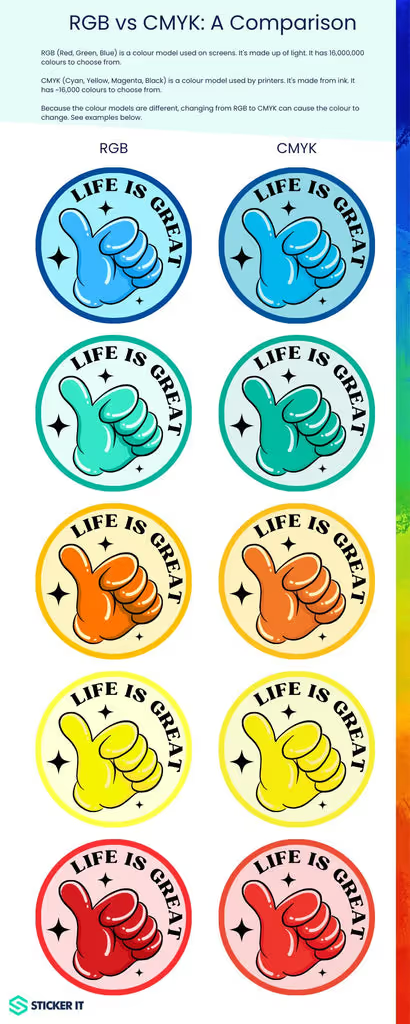How we print your stickers and labels

Want to learn more about the different ways your custom stickers and labels can be printed? This article is for you.
We’ll cover different printing technologies as well as full-color printing and how to prepare your artwork for the best possible outcome.
Different types of print technology: an overview
There are many different ways to print self-adhesive stickers and labels. At Sticker it, we use the world's best digital printer to give you perfect results every time.
But there’s much more to the world of custom printing.
Digital or traditional
The industry splits printers (aka presses) into two main categories: digital and traditional.
Digital printers use print heads to apply multiple colored inks or toners to a substrate (printable material) in one go. These presses usually print CMYK (cyan, magenta, yellow, and black - more on that later), but sometimes this is expanded to include white, orange, violet, green, and others so it's possible to print more colors.
Traditional printers use printing plates or screens to apply one color at a time. They’re extremely fast but expensive to set up compared to digital due to the need for plates or screens.
Singles, sheets, or rolls
Stickers and labels are printed onto sheets or long rolls (known as a web). The format often depends on the printer used.
Here's an example of an industrial, narrow web, roll-to-roll printer:

And this is what a sheetfed press looks like:

You can also get wide-format roll-to-roll printers, which are typically used for printing vehicle wraps.

Common digital print methods
- Inkjet: Popular for wide-format printing. Ink can be solvent, water-based, or UV-cured.
- Dry toner: Used by companies like Xeikon. Toner is cured rapidly using UV light.
- Digital offset: HP’s ElectroInk gets applied to a rubber blanket first, which gives a high-quality result.
- Thermal transfer: Ink from a wax-resin mix is transferred using heat and pressure.
Common traditional print methods
- Offset: A chemically treated plate transfers ink to a blanket, then to the substrate.
- Screen printing: Ink is pushed through a mesh stencil using a rubber squeegee.
- Flexo: A flexible plate on a roller applies ink directly to the media. Modern versions can print up to 750 meters per minute.
Do you print in full color?
Yes, we use full-color printing technology to make your stickers look amazing.
We print up to 8 colors at once to achieve the widest possible color gamut. Since we can print white ink, we can back transparent materials with white so your colors remain vibrant.
Learn more about printing white ink.

CMYK vs RGB: What can and can't be printed
We used a lot of acronyms thus far. What do all these terms mean & how do they impact you? We'll explain all this & more in the next few minutes.
What is RGB?
RGB stands for Red, Green, Blue; three hues of light we can mix to create different colors.
16,777,216 colors, to be exact.
We mix between 0-255 units of each color to create each RGB color. RGB is an additive color model, which means we add more color to get to white. Like this:

See how it differs from CMYK colors, where the more ink we add, the closer to black we get.
RGB color gamuts are used by things that use light to create color - for example; computer screens and TVs.
Read how colors are printed.
What is CMYK?
CMYK stands for Cyan, Yellow, Magenta, and Black (key). We can mix these colors to create about 16,000 different colors.
CMYK is a subtractive color model, which means we remove color to get to white, as shown in the image above.
Many printers use CMYK along with white ink to create opacity when printing on clear vinyl. Some printers add other colors to these four basic colors to increase the color gamut.
Three popular colors to add are; Orange, Violet & Green.
Here is an example of an orange printed in CMYK (right) vs the original (left). As you can see the CMYK color isn't a good match and needs the additional orange in CMYKOVG to get a better match.

Pantone themselves says that CMYK printers can print 55% of Pantone spot colors, whereas CMYKOVG can print 90% of Pantone spot colors - this is a massive difference. (Source)
How does all this affect printing?
There are 16+ million RGB colors and only 16,000 CMYK colors, or a few hundred more if your printer prints CMYKOVG.
This image helps to show the differences in the color gamut:

Here is a photo in CMYK and RGB side-by-side:

Designing on your computer that works in RGB can be risky because it gives us hundreds of beautiful vibrant colors that cannot be printed unless we get expensive spot colors made.
Your best bet is to design using CMYK colors to ensure you get the most accurate possible representation of the color.
Wow, now you know everything there is to know about the world of sticker and label printing. If you need a little more help with finding the perfect sticker or label for you, you can:
- get custom samples printed to test your design on one of our materials
- take a closer look at each material by ordering a sample pack
- reach out to our customer service team
- or take our quiz to find your perfect material
Subscribe to our newsletter
Enter your email below to stay up to date on Sticker it's latest, including new product launches, exclusive deals and more.

